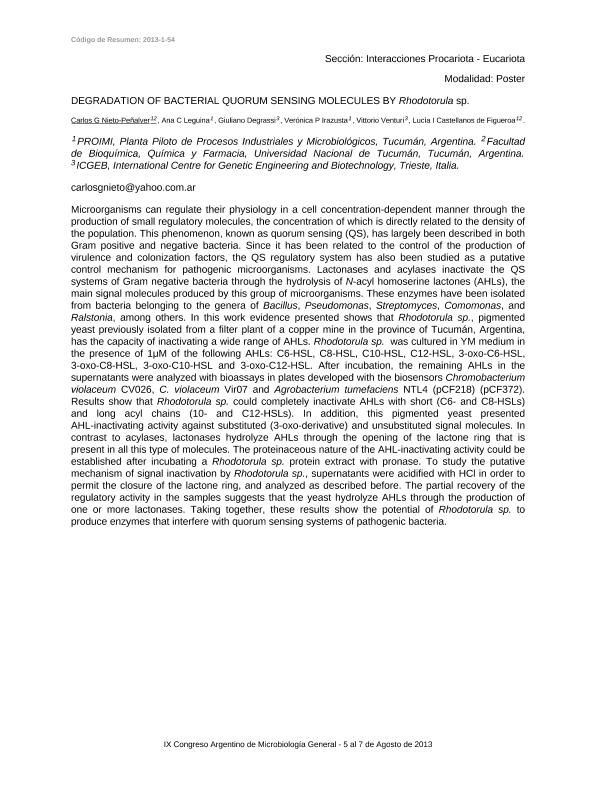Mostrar el registro sencillo del ítem
dc.contributor.author
Nieto Peñalver, Carlos Gabriel

dc.contributor.author
Leguina, Ana Carolina del Valle

dc.contributor.author
Degrassi, Giuliano
dc.contributor.author
Irazusta, Verónica Patricia

dc.contributor.author
Venturi, Vittorio
dc.contributor.author
Castellanos, Lucia Ines

dc.date.available
2023-03-21T14:47:49Z
dc.date.issued
2013
dc.identifier.citation
Degradation of bacterial quorum sensing molecules by Rhodotorula sp.; IX Congreso Argentino de Microbiología General; Rosario; Argentina; 2013; 1-1
dc.identifier.uri
http://hdl.handle.net/11336/191188
dc.description.abstract
Microorganisms can regulate their physiology in a cell concentration-dependent manner through the production of small regulatory molecules, the concentration of which is directly related to the density of the population. This phenomenon, known as quorum sensing (QS), has largely been described in both Gram positive and negative bacteria. Since it has been related to the control of the production of virulence and colonization factors, the QS regulatory system has also been studied as a putative control mechanism for pathogenic microorganisms. Lactonases and acylases inactivate the QS systems of Gram negative bacteria through the hydrolysis of N-acyl homoserine lactones (AHLs), the main signal molecules produced by this group of microorganisms. These enzymes have been isolated from bacteria belonging to the genera of Bacillus, Pseudomonas, Streptomyces, Comomonas, and Ralstonia, among others. In this work evidence presented shows that Rhodotorula sp., pigmented yeast previously isolated from a filter plant of a copper mine in the province of Tucumán, Argentina, has the capacity of inactivating a wide range of AHLs. Rhodotorula sp. was cultured in YM medium in the presence of 1μM of the following AHLs: C6-HSL, C8-HSL, C10-HSL, C12-HSL, 3-oxo-C6-HSL, 3-oxo-C8-HSL, 3-oxo-C10-HSL and 3-oxo-C12-HSL. After incubation, the remaining AHLs in the supernatants were analyzed with bioassays in plates developed with the biosensors Chromobacterium violaceum CV026, C. violaceum Vir07 and Agrobacterium tumefaciens NTL4 (pCF218) (pCF372). Results show that Rhodotorula sp. could completely inactivate AHLs with short (C6- and C8-HSLs) and long acyl chains (10- and C12-HSLs). In addition, this pigmented yeast presented AHL-inactivating activity against substituted (3-oxo-derivative) and unsubstituted signal molecules. In contrast to acylases, lactonases hydrolyze AHLs through the opening of the lactone ring that is present in all this type of molecules. The proteinaceous nature of the AHL-inactivating activity could be established after incubating a Rhodotorula sp. protein extract with pronase. To study the putative mechanism of signal inactivation by Rhodotorula sp., supernatants were acidified with HCl in order to permit the closure of the lactone ring, and analyzed as described before. The partial recovery of the regulatory activity in the samples suggests that the yeast hydrolyze AHLs through the production of one or more lactonases. Taking together, these results show the potential of Rhodotorula sp. to produce enzymes that interfere with quorum sensing systems of pathogenic bacteria.
dc.format
application/pdf
dc.language.iso
eng
dc.publisher
Sociedad Argentina de Microbiología General
dc.rights
info:eu-repo/semantics/openAccess
dc.rights.uri
https://creativecommons.org/licenses/by-nc-sa/2.5/ar/
dc.subject
quorum sensing
dc.subject
Rhodotorula sp
dc.subject.classification
Biología Celular, Microbiología

dc.subject.classification
Ciencias Biológicas

dc.subject.classification
CIENCIAS NATURALES Y EXACTAS

dc.title
Degradation of bacterial quorum sensing molecules by Rhodotorula sp.
dc.type
info:eu-repo/semantics/publishedVersion
dc.type
info:eu-repo/semantics/conferenceObject
dc.type
info:ar-repo/semantics/documento de conferencia
dc.date.updated
2023-03-15T20:39:48Z
dc.journal.pagination
1-1
dc.journal.pais
Argentina

dc.journal.ciudad
Rosario
dc.description.fil
Fil: Nieto Peñalver, Carlos Gabriel. Consejo Nacional de Investigaciones Científicas y Técnicas. Centro Científico Tecnológico Conicet - Tucumán. Planta Piloto de Procesos Industriales Microbiológicos; Argentina
dc.description.fil
Fil: Leguina, Ana Carolina del Valle. Consejo Nacional de Investigaciones Científicas y Técnicas. Centro Científico Tecnológico Conicet - Tucumán. Planta Piloto de Procesos Industriales Microbiológicos; Argentina
dc.description.fil
Fil: Degrassi, Giuliano. International Centre For Genetic Engineering And Biotec; Italia
dc.description.fil
Fil: Irazusta, Verónica Patricia. Consejo Nacional de Investigaciones Científicas y Técnicas. Centro Científico Tecnológico Conicet - Tucumán. Planta Piloto de Procesos Industriales Microbiológicos; Argentina
dc.description.fil
Fil: Venturi, Vittorio. International Centre For Genetic Engineering And Biotec; Italia
dc.description.fil
Fil: Castellanos, Lucia Ines. Consejo Nacional de Investigaciones Científicas y Técnicas. Centro Científico Tecnológico Conicet - Tucumán. Planta Piloto de Procesos Industriales Microbiológicos; Argentina
dc.relation.alternativeid
info:eu-repo/semantics/altIdentifier/url/https://samige.org.ar/wp-content/uploads/2022/10/Libro-samige-2013.pdf
dc.conicet.rol
Autor

dc.conicet.rol
Autor

dc.conicet.rol
Autor

dc.conicet.rol
Autor

dc.conicet.rol
Autor

dc.conicet.rol
Autor

dc.coverage
Nacional
dc.type.subtype
Congreso
dc.description.nombreEvento
IX Congreso Argentino de Microbiología General
dc.date.evento
2013-08-05
dc.description.ciudadEvento
Rosario
dc.description.paisEvento
Argentina

dc.type.publicacion
Book
dc.description.institucionOrganizadora
Sociedad Argentina de Microbiología General
dc.source.libro
Libro de resúmenes del IX Congreso Argentino de Microbiología General
dc.date.eventoHasta
2013-08-07
dc.type
Congreso
Archivos asociados
